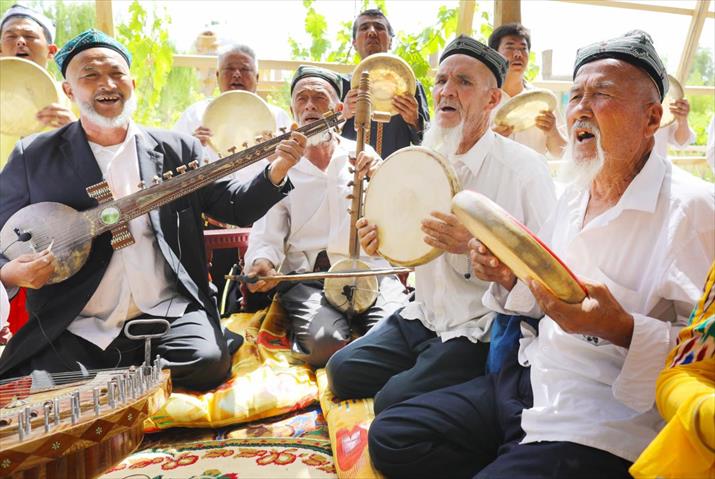|
||||||||||
| Home Nation World Business Opinion Lifestyle ChinAfrica Multimedia Columnists Documents Special Reports |
|
||||||||||
| Home Nation World Business Opinion Lifestyle ChinAfrica Multimedia Columnists Documents Special Reports |
| China |
| Valuing the Past |
| Cultural tourism helps preserve historical architecture and develop traditional arts in Xinjiang |
| By Li Xiaoyu | VOL. 9 July 2017 ·2017-07-10 |

Uygur musicians keep their traditions alive (ZHU XINGXIN/CHINA DAILY)
As the sun rises over Kazanqi in northwest China, the early morning silence is broken only by the tinkling sound of a horse's sleigh bells. The old horse-drawn carriage bringing the day's first visitors make its way slowly through the Kazanqi Folk Tourism District, a triple-A scenic spot in the Xinjiang Uygur Autonomous Region.
No tourist buses or cars are allowed here. Visitors travel around the area using traditional means of transportation, which probably explains why people are heading there from all over China.
Located south of Yining, capital of Xinjiang's Ili Kazak Autonomous Prefecture, Kazanqi might seem like an idyllic place in the eyes of visitors, but it was not always the case. In fact, according to local residents, life today is much better than it used to be. The development of local cultural tourism has accomplished two things at same time, namely, improving the quality of life of locals and helping preserve their cultural heritage in a sustainable way.
Warm welcome
Kazanqi Folk Tourism District's main attraction is obvious to anyone taking a stroll along its main street. Traditional Uygur houses, with columned porticos, large wooden doors and elaborate window shutters, are perfect settings for photographers. Elderly Uygurs sitting on benches nearby, welcome visitors to look at their charming inner courtyards.
Among them is 54-year-old Asiyam Iz. Her blue and white house - symbolizing heaven and purity, according to Uygur tradition - gleams in the sun. Built almost a century ago, her home has housed three generations of her family, and now welcomes visitors from all over the world with cakes and milk tea. Tourists can take shelter from the heat on cushions under the grapevine in the courtyard.
For Iz, the arrival of tourists has brought much-needed change to her life. In the past, her house was poorly maintained and threatened to collapse. The same was true for the whole neighborhood. "Before, we had only a dirt road. It was dusty under the sun and muddy in the rain. Now things are much better," she told ChinAfrica.
In 2006, the local administration began to regenerate this historic place, equipping century-old houses with all the necessary amenities and providing modern facilities such as running water, street lighting and paved roads. In total, 114 million yuan ($17 million) was invested to turn the neighborhood into a first-class tourist area. A few years later, the revitalized place has grown in popularity and now attracts scores of visitors.
In addition, families whose houses are open to visitors receive a portion of the ticket sales revenue. Their share of revenue rises with the popularity of their houses. Therefore, Iz now receives more than 2,000 yuan (about $300) per month in the peak season. "I am now financially independent," she said.
According to Yining City Tourism Administration, Kazanqi welcomed 30,000 visitors in 2015 alone, generating a revenue of 1.5 million yuan ($210,000), of which more than half was redistributed to local families.
"By building on our rich cultural and historical resources, we intend to give a new impetus to our economy and improve the living conditions of our people," said Tang Xiaorong, Vice Mayor of Yining City.
Cultural preservation
Traditional arts also benefit from cultural tourism development. Visitors in Awat County of Aksu Prefecture in South Xinjiang can now enjoy the muqam, a traditional Uygur art performance that was once threatened with extinction.
On a large stage in front of enthusiastic tourists, Abdukadir Musha, 74, leads 50 other artists - all of whom are his pupils. Sitting on their knees, the troupe sings popular ballads on the history and current life of the Uygur people. Traditional instruments, such as the harp, zither, drums and pan flute, provide the music. In front of them, about 40 dancers wearing colorful traditional costumes perform for the audience.
In the past, this was a common scene at Uygur festivals and wedding ceremonies. "But nowadays, celebrations like this, where everyone participates in the muqam, are increasingly rare. And the interest of young people in our customs is declining year after year," said Musha, who is one of the well-known masters of muqam.
Here also, the local administration was quick to act. In the 1980s, artistic troupes and research institutes dedicated to Xinjiang's muqam were put in place in order to collect, study and promote the classical music, songs and dances of the Uygur people. In 2005, muqam was included in UNESCO's list of the Intangible Cultural Heritage of Humanity.
Since then, local authorities have paid particular attention to support muqam masters such as Musha. Those appointed as inheritors of this cultural heritage form can receive monthly subsidies. As such, Musha receives about 1,000 yuan ($150) per month in exchange for providing training. So far, he has trained more than 300 people.
Together with his pupils, he also gives performances in areas frequented by tourists like the Dolan Tribe Area, which has welcomed almost 2 million visitors from all over the world over the last nine years, according to Awat District Tourism Administration.
"My family has been involved in preserving the art of muqam for six generations. In the past, I was worried about the future of this tradition, but I am not worried anymore," he told ChinAfrica. "On the contrary, with the efforts of the government, we can not only awaken the passion of the younger generation for traditional art, but also share our historical treasures with foreign visitors and spectators."
| About Us | Contact Us | Advertise with Us | Subscribe |
| Copyright Beijing Review All rights reserved 京ICP备08005356号-5 京公网安备110102005860号 |